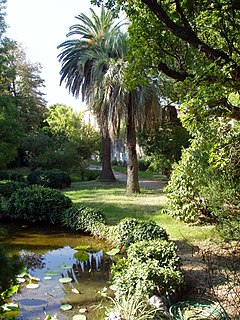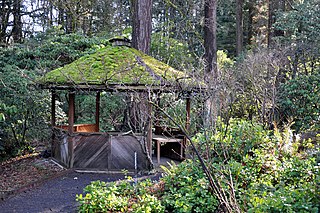
Royal Botanic Gardens, Kew, is a non-departmental public body in the United Kingdom sponsored by the Department for Environment, Food and Rural Affairs. An internationally important botanical research and education institution, it employs 1,100 staff. Its board of trustees is chaired by Dame Amelia Fawcett.

A botanical garden or botanic garden is a garden dedicated to the collection, cultivation, preservation and display of a wide range of plants labelled with their botanical names. It may contain specialist plant collections such as cacti and other succulent plants, herb gardens, plants from particular parts of the world, and so on; there may be greenhouses, shadehouses, again with special collections such as tropical plants, alpine plants, or other exotic plants. Visitor services at a botanical garden might include tours, educational displays, art exhibitions, book rooms, open-air theatrical and musical performances, and other entertainment.

A seed bank stores seeds to preserve genetic diversity; hence it is a type of gene bank. There are many reasons to store seeds. One is to preserve the genes that plant breeders need to increase yield, disease resistance, drought tolerance, nutritional quality, taste, etc. of crops. Another is to forestall loss of genetic diversity in rare or imperiled plant species in an effort to conserve biodiversity ex situ. Many plants that were used centuries ago by humans are used less frequently now; seed banks offer a way to preserve that historical and cultural value. Collections of seeds stored at constant low temperature and low moisture are guarded against loss of genetic resources that are otherwise maintained in situ or in field collections. These alternative "living" collections can be damaged by natural disasters, outbreaks of disease, or war. Seed banks are considered seed libraries, containing valuable information about evolved strategies to combat plant stress, and can be used to create genetically modified versions of existing seeds. The work of seed banks spans decades and even centuries. Most seed banks are publicly funded and seeds are usually available for research that benefits the public.

Ulmus rubra, the slippery elm, is a species of elm native to eastern North America, ranging from southeast North Dakota, east to Maine and southern Quebec, south to northernmost Florida, and west to eastern Texas, where it thrives in moist uplands, although it will also grow in dry, intermediate soils. Other common names include red elm, gray elm, soft elm, moose elm, and Indian elm. The tree was first named as part of Ulmus americana in 1753, but identified as a separate species, Ulmus rubra, in 1793 by Pennsylvania botanist Gotthilf Muhlenberg. The slightly later name U. fulva, published by French botanist André Michaux in 1803, is still widely used in dietary-supplement and alternative-medicine information.

Damasonium alisma is a species of flowering marsh plant known by the common name of starfruit. Its native range includes parts of Great Britain, France, Portugal, Spain, Italy, Greece, Russia, Ukraine, Moldova, and Kazakhstan.

Wakehurst, previously known as Wakehurst Place, is a house and botanic gardens in West Sussex, England, owned by the National Trust but used and managed by the Royal Botanic Gardens, Kew. It is near Ardingly, West Sussex in the High Weald, and comprises a late 16th-century mansion, a mainly 20th-century garden and, in a modern building, Kew's Millennium Seed Bank. Visitors are able to see the gardens, the Mansion, and also visit the seed bank. The garden today covers some 2 km2 and includes walled and water gardens, woodland and wetland conservation areas.
Sir Peter Crane, FRS is the current President of the Oak Spring Garden Foundation and Senior Research Scientist in the School of Forestry and Environmental Studies at Yale University. In addition to his work in leading and developing educational and natural history organizations, including the Field Museum in Chicago and the Royal Botanic Gardens, Kew, he has had a long career as a professor and researcher in both the U.K. and the United States. He is best known for his work on the origin and early evolution of flowering plants (angiosperms) based on studies of the plant fossil record. His popular writing includes Ginkgo: The Tree That Time Forgot, a book that traces the evolution and cultural history of Ginkgo biloba to the present day.

The Chicago Botanic Garden is a 385-acre (156 ha) living plant museum situated on nine islands in the Cook County Forest Preserves. It features 27 display gardens in four natural habitats: McDonald Woods, Dixon Prairie, Skokie River Corridor, and Lakes and Shores. The address for the garden is 1000 Lake Cook Road, Glencoe, Illinois. The garden is open every day of the year and admission is currently free; however, an admission fee has been approved to start in 2022, not to exceed $35.

Berry Botanic Garden was a botanical garden in southwest Portland, Oregon, in the United States. In addition to large collections of alpine plants, rhododendrons, primulas, and lilies, it was known for its plant-conservation program and its large seed bank that protects rare or endangered plants of the Pacific Northwest. The seed bank, formally established in 1983, was thought to be the first in the U.S. that was devoted entirely to preserving rare native plants.
The Esmée Fairbairn Foundation is a registered charity founded in England in 1961. It is one of the larger independent grantmaking foundations based in the UK, funding organisations which aim to improve the quality of life for people and communities in the UK.

"Jawaharlal Nehru Tropical Botanic Garden and Research Institute", renamed in the fond memory of visionary Prime Minister of India Shri Pandit Jawaharlal Nehru is an autonomous Institute established by the Government of Kerala on 17 November 1979 at Thiruvananthapuram, the capital city of Kerala. It functions under the umbrella of the Kerala State Council for Science, Technology and Environment (KSCSTE), Government of Kerala. The Royal Botanic Gardens (RBG), Kew played an exemplary and significant role in shaping and designing the lay out of the JNTBGRI garden in its formative stages.

The Millennium Seed Bank Partnership, formerly known as the Millennium Seed Bank Project, is the largest ex situ plant conservation programme in the world coordinated by the Royal Botanic Gardens, Kew. After being awarded a Millennium Commission grant in 1995, the project commenced in 1996, and is now housed in the Wellcome Trust Millennium Building situated in the grounds of Wakehurst Place, West Sussex. Its purpose is to provide an "insurance policy" against the extinction of plants in the wild by storing seeds for future use. The storage facilities consist of large underground frozen vaults preserving the world's largest wild-plant seedbank or collection of seeds from wild species. The project had been started by Dr Peter Thompson and run by Paul Smith after the departure of Roger Smith. Roger Smith was awarded the OBE in 2000 in the Queen's New Year Honours for services to the Project.

Sir Henry Philip Price, 1st Baronet was a British businessman and philanthropist.

Kunming Institute of Botany, or KIB, founded in 1938, is a research institution in the field of Botany, which is located in Kunming, the capital of Yunnan Province, China.
Roger Smith is a UK biologist and founder of the Millennium Seed Bank Project. He was awarded an OBE in the 2000 New Year Honours List for services to the project.

Kew Gardens is a botanic garden in southwest London that houses the "largest and most diverse botanical and mycological collections in the world". Founded in 1840, from the exotic garden at Kew Park in Middlesex, England, its living collections includes some of the 27,000 taxa curated by Royal Botanic Gardens, Kew, while the herbarium, which is one of the largest in the world, has over 8.5 million preserved plant and fungal specimens. The library contains more than 750,000 volumes, and the illustrations collection contains more than 175,000 prints and drawings of plants. It is one of London's top tourist attractions and is a World Heritage Site.
The Oman Botanic Garden is a development of the Diwan of Royal Court in Oman, growing unique plants, landscapes and covering cultural traditions of Oman. The garden is currently under construction. When it opens it will showcase all of the native plant species of Oman in a series of created, naturalistic habitats from the dry deserts to the rich monsoon cloud forests. The garden will also showcase the traditionally cultivated crops and the many ways that people use plants in Oman.

Pyrus cordata, the Plymouth pear, is a rare wild species of pear belonging to the family Rosaceae. It gets its name from the city of Plymouth in Devon, where it was originally found in 1870 The Plymouth pear was one of the British trees to be funded under English Natures Species Recovery Programme.
Dame Caroline Louise Mason has been the Chief Executive Officer of the Esmée Fairbairn Foundation since 2013, a UK charity that supports improvement of life through strategic grants and investment.
The European Native Seeds Conservation Network (ENSCONET) is a conservation group for the preservation of wild species by maintaining a germplasm bank. It is made up of 24 institutions from 17 member states of the European Union, as well as five associate members. The network is coordinated by the "Millennium Seed Bank" of the Royal Botanic Gardens, Kew, United Kingdom and is founded under the auspices of the 6th "Research Framework Program" of the EU, and covers 5 of the 6 European biogeographic regions.














